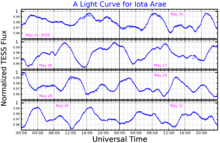Iota Arae
| Observation data Epoch J2000 Equinox J2000 | |
|---|---|
| Constellation | Ara |
| Right ascension | 17h 23m 16.07624s[1] |
| Declination | −47° 28′ 05.5057″[1] |
| Apparent magnitude (V) | 5.18 - 5.26[2] |
| Characteristics | |
| Spectral type | B2 IVe + sdO[3] |
| U−B color index | −0.82[4] |
| B−V color index | −0.11[4] |
| R−I color index | −0.08 |
| Variable type | BE[2] |
| Astrometry | |
| Radial velocity (Rv) | −19[5] km/s |
| Proper motion (μ) | RA: −6.209[1] mas/yr Dec.: −17.699[1] mas/yr |
| Parallax (π) | 3.5613±0.0904 mas[1] |
| Distance | 920 ± 20 ly (281 ± 7 pc) |
| Absolute magnitude (MV) | −2.06[6] |
| Orbit[3] | |
| Period (P) | 176.17 ± 0.04 d |
| Inclination (i) | 46 ± 6° |
| Periastron epoch (T) | HJD 2458654.2 ± 0.5 |
| Semi-amplitude (K1) (primary) | 5.80 ± 0.06 km/s |
| Semi-amplitude (K2) (secondary) | 57.6 ± 0.6 km/s |
| Details | |
| ι Ara A | |
| Mass | 8.3±0.4[7] M☉ |
| Radius | 6.3[1] R☉ |
| Luminosity | 10,864[8] L☉ |
| Surface gravity (log g) | 4.18[8] cgs |
| Temperature | 20,172[1] K |
| Rotational velocity (v sin i) | 340[8] km/s |
| Age | 30.0±7.4[7] Myr |
| ι Ara B | |
| Mass | 1.06±0.29[3] M☉ |
| Radius | 0.61±0.09[9] R☉ |
| Luminosity | 437[9] L☉ |
| Temperature | 33,800[9] K |
| Other designations | |
| ι Ara, CD−47°11484, FK5 3379, HD 157042, HIP 85079, HR 6451, NSV 8566, SAO 227886.[10] | |
| Database references | |
| SIMBAD | data |
Iota Arae, Latinized from ι Arae, is the Bayer designation for a star in the southern constellation of Ara. It is 920 light-years (281 parsecs) from Earth, give or take a 20 light-year margin of error, and has an apparent visual magnitude of 5.2. Based upon the Bortle Dark-Sky Scale, this means the star is visible to the naked eye from suburban skies.
This is an evolved subgiant star with a stellar classification of B2 IVe.[3] The 'e' notation indicates the spectrum displays emission lines, which means this is a Be star that is surrounded by hot, circumstellar gas. It is spinning rapidly with a projected rotational velocity of 340 km/s. The Doppler effect from this rotation is causing the absorption lines to widen and become nebulous, as indicated by the 'n' notation in the stellar class. It is a spectroscopic binary, and is in an orbit with a second, smaller component, a subdwarf O star.[3]

Iota Arae has around 8.3 times the mass of the Sun and is shining brightly with 10,864 times the Sun's luminosity. This energy is being radiated into space from the outer atmosphere at an effective temperature of 20,172 K, giving it the characteristic blue-white hue of a B-type star.[12] The General Catalog of Variable Stars classifies it as a BE variable star, ranging from visual magnitude 5.18 to 5.26 with a period of 13.36 hours.[2] In a study of the Hipparcos data, it was found to vary in brightness by 0.054 in magnitude with no clear period.[13]
References
[edit]- ^ a b c d e f g Vallenari, A.; et al. (Gaia collaboration) (2023). "Gaia Data Release 3. Summary of the content and survey properties". Astronomy and Astrophysics. 674: A1. arXiv:2208.00211. Bibcode:2023A&A...674A...1G. doi:10.1051/0004-6361/202243940. S2CID 244398875. Gaia DR3 record for this source at VizieR.
- ^ a b c Samus, N. N.; Durlevich, O. V.; et al. (2009). "VizieR Online Data Catalog: General Catalogue of Variable Stars (Samus+ 2007-2013)". VizieR On-line Data Catalog: B/GCVS. Originally Published in: 2009yCat....102025S. 1. Bibcode:2009yCat....102025S.
- ^ a b c d e Wang, Luqian; Gies, Douglas R.; Peters, Geraldine J.; Han, Zhanwen (April 2023). "The Orbital and Physical Properties of Five Southern Be+sdO Binary Systems". The Astronomical Journal. 165 (5): 203. arXiv:2303.12616. Bibcode:2023AJ....165..203W. doi:10.3847/1538-3881/acc6ca. ISSN 1538-3881.
- ^ a b Kozok, J. R. (September 1985). "Photometric observations of emission B-stars in the southern Milky Way". Astronomy and Astrophysics Supplement Series. 61: 387–405. Bibcode:1985A&AS...61..387K.
- ^ Evans, D. S. (June 20–24, 1966). "The Revision of the General Catalogue of Radial Velocities". In Alan Henry, Batten; John Frederick, Heard (eds.). Proceedings from IAU Symposium no. 30. Determination of Radial Velocities and Their Applications. Vol. 30. University of Toronto: International Astronomical Union. p. 57. Bibcode:1967IAUS...30...57E.
- ^ Anderson, E.; Francis, Ch. (2012). "XHIP: An extended hipparcos compilation". Astronomy Letters. 38 (5): 331. arXiv:1108.4971. Bibcode:2012AstL...38..331A. doi:10.1134/S1063773712050015. S2CID 119257644.
- ^ a b Tetzlaff, N.; Neuhäuser, R.; Hohle, M. M. (January 2011). "A catalogue of young runaway Hipparcos stars within 3 kpc from the Sun". Monthly Notices of the Royal Astronomical Society. 410 (1): 190–200. arXiv:1007.4883. Bibcode:2011MNRAS.410..190T. doi:10.1111/j.1365-2966.2010.17434.x. S2CID 118629873.
- ^ a b c Zorec, J.; et al. (November 2016). "Critical study of the distribution of rotational velocities of Be stars. I. Deconvolution methods, effects due to gravity darkening, macroturbulence, and binarity". Astronomy & Astrophysics. 595: 26. Bibcode:2016A&A...595A.132Z. doi:10.1051/0004-6361/201628760. hdl:11336/37946.
- ^ a b c Wang, Luqian; Gies, Douglas R.; Peters, Geraldine J.; Götberg, Ylva; Chojnowski, S. Drew; Lester, Kathryn V.; Howell, Steve B. (2021). "The Detection and Characterization of Be+sdO Binaries from HST/STIS FUV Spectroscopy". The Astronomical Journal. 161 (5): 248. arXiv:2103.13642. Bibcode:2021AJ....161..248W. doi:10.3847/1538-3881/abf144.
- ^ "iot Ara". SIMBAD. Centre de données astronomiques de Strasbourg. Retrieved 2010-07-30.
- ^ "MAST: Barbara A. Mikulski Archive for Space Telescopes". Space Telescope Science Institute. Retrieved 8 December 2021.
- ^ "The Colour of Stars". Australia Telescope, Outreach and Education. Commonwealth Scientific and Industrial Research Organisation. December 21, 2004. Archived from the original on February 22, 2012. Retrieved 2012-01-16.
- ^ Lefèvre, L.; et al. (November 2009). "A systematic study of variability among OB-stars based on HIPPARCOS photometry". Astronomy and Astrophysics. 507 (2): 11411201. Bibcode:2009A&A...507.1141L. doi:10.1051/0004-6361/200912304.


 French
French Deutsch
Deutsch